Endurance Events and Lactate Testing
With Emphasis on the Triathlon
9 of 19
Protocol Design Considerations
General Considerations
As a starting point these procedures and protocols should only be used on healthy athletes who have trained for some time, 2-3 years in the triathlon or related sports. If someone can complete an Olympic length triathlon in reasonable time and have no serious health issues, lactate testing can be helpful. Lactate testing is not appropriate for novices, until they have some training under their belts.
It is obvious that all variables that can affect the lactate result must be as controlled as practical. Recent competition or hard training should be avoided, and time of day should be consistent from session to session. Weather is not entirely controllable, but it is important to realize it could have an impact on lactate readings. (See Modules on Consistent Testing)
We are frequently asked when to test and how often to test. It is best to test in a rest week. There should be a week every training cycle that is lower in intensity and volume than previous weeks. Near the end of this week is a good time to test. The athlete should be well rested for testing and this is the best opportunity. The purpose of testing is to assess how well conditioned the athlete is and testing after hard workouts would interfere with this. As far as how often, some where between every 5-8 weeks is usually enough. The coach can then readjust training based on the results for the next cycle.
Basic Elements of Protocols
Protocols are different depending on the performance level of the athlete. For a recreational athlete, it’s helpful just to know the approximate lactate value. They can do without a lot of samples and still benefit from each test. However, the better the athlete’s performance level, the more sample points are needed to improve the precision of the interpretation of the lactate test.
Basic Length of Stages and Rest:
Stages should be 5-8 minutes, to allow time for lactate levels to stabilize in the athlete. There should be minimal rest between stages – just long enough to take the sample. No more than one minute rest should be allowed, because recovery should not begin between stages. Here are two charts that show the effect on lactate of different step durations and rest between steps.
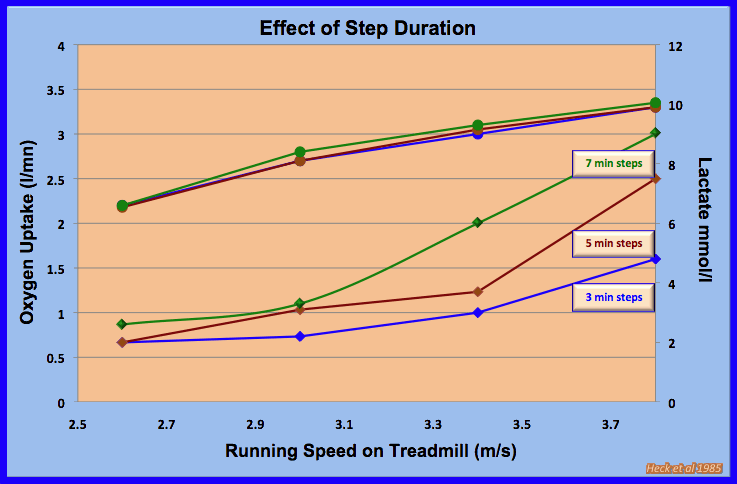
Notice in the above chart that there are dramatic differences between where one would put the threshold or the V4 for each of the three step lengths. Also note that the heart rates would give no indication of what has changed between the three protocols.
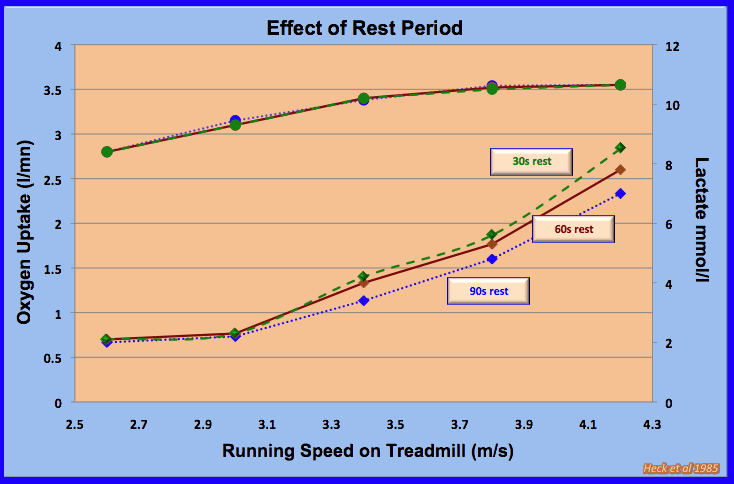
Rest period length can also change the results enough to yield different interpretations. Here also, heart rates show no difference between protocols.
The amount of difference in effort level between stages depends on how many readings are desired. If there are small increments in speed, the stages can be shorter; if the increments are large, the stages should be on the long side.
How to Take the Sample:
It is generally best to take blood from the earlobe since the ear is less pain-sensitive, its skin is thinner and it is easier to vasodilate (open) ear capillaries compared to finger capillaries. Usually only a single puncture in the ear is needed to provide blood samples for more than one reading. Also, there is less sweat on the earlobe than the fingers, thus less chance for sweat to contaminate the lactate reading. Finger-sticks are possible and are mainly what is used in the US. If you have nobody to help take the blood, it is the only option. However the finger should be warm (to optimize blood flow) and very clean. The site should be washed with soap and water before lancing. Also, collecting blood with a glass capillary tube before proceeding to the actual blood analysis improves the accuracy of the measure.
When to Take the Samples:
During a multiple step test a blood sample is taken immediately after every step. No second sample is needed, since one-minute rest is usually the most between steps.
For a protocol ending in a sub-maximal test (test ending with a lactate below 6 mmol/l but above 4 mmol/l), blood should be taken at 1 and possibly at 3 minutes after the exercise. It is unusual to need more than two samples after sub-maximal efforts.
For the interpretation of the tests in which the last stage is above threshold, the highest concentration of lactate after each effort should be used. In order to make sure you have the highest value, at least 2 samples at 2-minute intervals should be taken. As long as the latest measured lactate value remains higher than the previous measurement, you should keep taking more samples 2 minutes after the previous one.
After a maximal effort (an all-out effort between 30s and 90s), blood lactate can increase for several minutes because lactate distribution proceeds from inside the cell outward. Therefore, there is no point in taking the sample at 1 minute after the all-out effort. Rather, start blood sampling at 3 minutes. The next sample should occur at 5 minutes. As long as the last sample is higher than the previous, an extra sample must be taken in 2-minute time intervals. Three or more samples may be needed. Because triathletes usually have high aerobic capacities and low anaerobic capacities, they usually reach the highest post-exercise lactate concentration quickly at the first or second reading after a max test, but sometimes you are surprised by how much lactate they generate. Here are two charts that illustrate lactate build up during a step test and its subsequent decline.
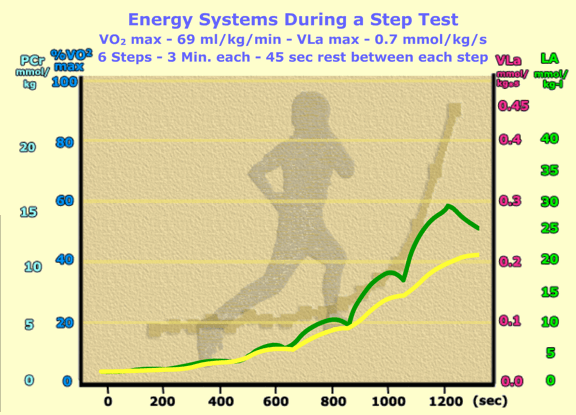
Lactate in muscles and blood during a step test
The muscle lactate is the green line and blood lactate is the yellow line. Notice the muscle lactate at the cessation of exercise. It is considerably higher than the blood lactate and this means that the blood lactate will continue to rise till the two are in equilibrium.
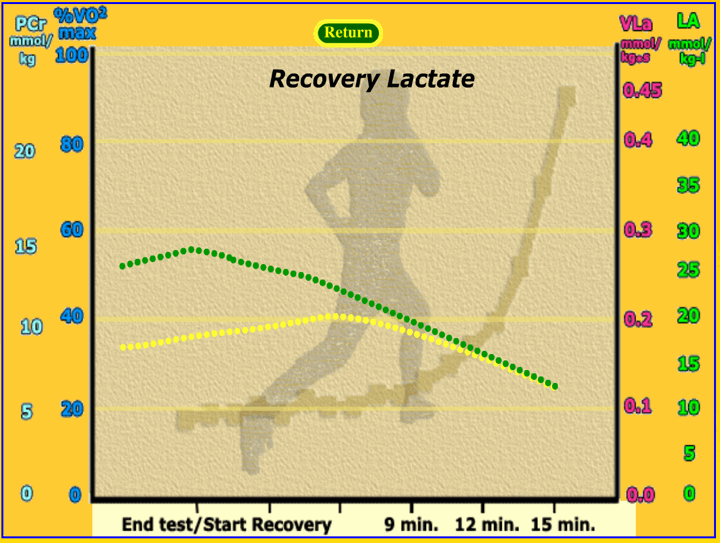
muscle and blood lactate levels during recovery from a step test
The blood lactate curve only starts to drop after about 7 minutes. This will vary substantially by athlete. Here are the recovery curves for four elite swimmers. Most of these athletes are much more anaerobic than triathletes, but the chart indicates what one can expect from some all-out efforts. This was after 100 m in their strongest stroke.
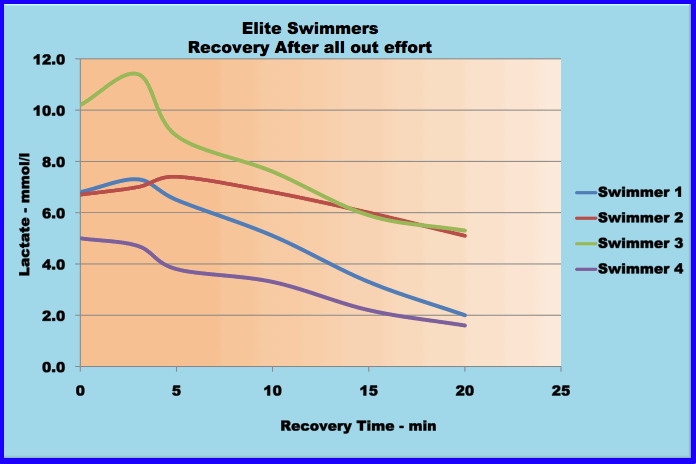
elite swimmers lactate recovery curves
There are some situations where you can skip taking more than one sample:
- sub-maximal effort for recreational athlete
- control test after a set at nearly constant, sub-maximal speed and lasting for longer than 10 minutes
Continue on to Module 10 which discussess specific protocols for testing triathletes and their interpretation
Module 10 of 19- specific protocols for testing triathletes and their interpretation
